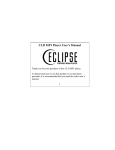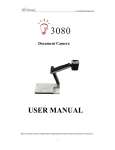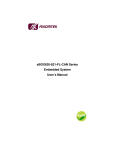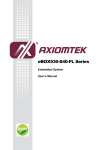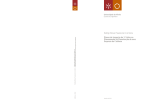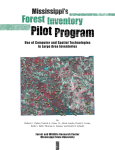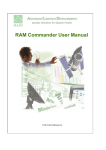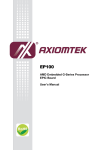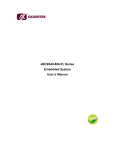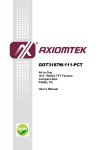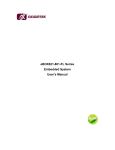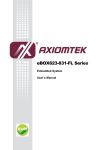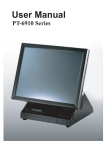Download DSB310-110 Fanless Digital Signage Player User`s Manual
Transcript
DSB310-110 Fanless Digital Signage Player User’s Manual Disclaimers This manual has been carefully checked and believed to contain accurate information. Axiomtek Co., Ltd. assumes no responsibility for any infringements of patents or any third party’s rights, and any liability arising from such use. Axiomtek does not warrant or assume any legal liability or responsibility for the accuracy, completeness or usefulness of any information in this document. Axiomtek does not make any commitment to update the information in this manual. Axiomtek reserves the right to change or revise this document and/or product at any time without notice. No part of this document may be reproduced, stored in a retrieval system, or transmitted, in any form or by any means, electronic, mechanical, photocopying, recording, or otherwise, without the prior written permission of Axiomtek Co., Ltd. Copyright 2012 Axiomtek Co., Ltd. All Rights Reserved May 2012, Version A1 Printed in Taiwan ii Safety Precautions Before getting started, please read the following important safety precautions. 1. The DSB310-110 does not come equipped with an operating system. An operating system must be loaded first before installing any software into the computer. 2. Be sure to ground yourself to prevent static charge when installing the internal components. Use a grounding wrist strap and place all electronic components in any static-shielded devices. Most electronic components are sensitive to static electrical charge. 3. Disconnect the power cord from the DSB310-110 before making any installation. Be sure both the system and the external devices are turned OFF. Sudden surge of power could ruin sensitive components. Make sure the DSB310-110 is properly grounded. 4. Make sure the voltage of the power source is correct before connecting the equipment to the power outlet. 5. Turn OFF the system power before cleaning. Clean the system using a cloth only. Do not spray any liquid cleaner directly onto the screen. 6. Do not leave this equipment in an uncontrolled environment where the storage temperature is below -20℃ or above 80℃. It may damage the equipment. 7. Do not open the system’s back cover. If opening the cover for maintenance is a must, only a trained technician is allowed to do so. Integrated circuits on computer boards are sensitive to static electricity. To avoid damaging chips from electrostatic discharge, observe the following precautions: Before handling a board or integrated circuit, touch an unpainted portion of the system unit chassis for a few seconds. This will help to discharge any static electricity on your body. When handling boards and components, wear a wrist-grounding strap, available from most electronic component stores. iii Classification 1. Degree of production against electric shock : not classified 2. Equipment not suitable for use in the presence of a flammable anesthetic mixture with air or with oxygen or nitrous oxide. 3. Mode of operation : Continuous iv General Cleaning Tips You may need the following precautions before you begin to clean the computer. When you clean any single part or component for the computer, please read and understand the details below fully. When you need to clean the device, please rub it with a piece of dry cloth. 1. Be cautious of the tiny removable components when you use a vacuum cleaner to absorb the dirt on the floor. 2. Turn the system off before you start to clean up the component or computer. 3. Never drop the components inside the computer or get circuit board damp or wet. 4. Be cautious of all kinds of cleaning solvents or chemicals when you use it for the sake of cleaning. Some individuals may be allergic to the ingredients. 5. Try not to put any food, drink or cigarette around the computer. Cleaning Tools: Although many companies have created products to help improve the process of cleaning your computer and peripherals users can also use household items to clean their computers and peripherals. Below is a listing of items you may need or want to use while cleaning your computer or computer peripherals. Keep in mind that some components in your computer may only be able to be cleaned using a product designed for cleaning that component, if this is the case it will be mentioned in the cleaning. Cloth: A piece of cloth is the best tool to use when rubbing up a component. Although paper towels or tissues can be used on most hardware as well, we still recommend you to rub it with a piece of cloth. Water or rubbing alcohol: You may moisten a piece of cloth a bit with some water or rubbing alcohol and rub it on the computer. Unknown solvents may be harmful to the plastics parts. Vacuum cleaner: Absorb the dust, dirt, hair, cigarette particles, and other particles out of a computer can be one of the best methods of cleaning a computer. Over time these items can restrict the airflow in a computer and cause circuitry to corrode. Cotton swabs: Cotton swaps moistened with rubbing alcohol or water are excellent tools for wiping hard to reach areas in your keyboard, mouse, and other locations. Foam swabs: Whenever possible it is better to use lint free swabs such as foam swabs. Note: We strongly recommended that you should shut down the system before you start to clean any single components. Please follow the steps below: 1. Close all application programs 2. Close operating software 3. Turn off power switch 4. Remove all device v 5. vi Pull out power cable Scrap Computer Recycling If the computer equipments need the maintenance or are beyond repair, we strongly recommended that you should inform your Axiomtek distributor as soon as possible for the suitable solution. For the computers that are no longer useful or no longer working well, please contact your Axiomtek distributor for recycling and we will make the proper arrangement. Trademarks Acknowledgments Axiomtek is a trademark of Axiomtek Co., Ltd. Windows® is a trademark of Microsoft Corporation. AMI is trademark of American Megatrend Inc. IBM, PC/AT, PS/2, VGA are trademarks of International Business Machines Corporation. Intel® and Pentium® are trademarks of Intel Corporation. AMD is trademark of AMD Corporation, Inc. Other brand names and trademarks are the properties and registered Brands of their respective owners vii Table of Contents Disclaimers ............................................................................................................................. ii Safety Precautions ................................................................................................................ iii Classification ......................................................................................................................... iv General Cleaning Tips............................................................................................................ v Scrap Computer Recycling................................................................................................... vii CHAPTER 1 INTRODUCTION ................................................................................................... 1 1.1 General Description .............................................................................................. 2 1.2 System Specifications........................................................................................... 4 1.2.1 CPU ......................................................................................................................4 1.2.2 I/O System ............................................................................................................ 4 1.2.3 System Specification ............................................................................................ 5 1.3 Dimensions ........................................................................................................... 6 1.3.1 System Dimension ................................................................................................ 6 1.3.2 Wall mount Bracket Dimension ............................................................................ 7 1.4 I/O Outlets ............................................................................................................. 8 1.5 Packing List ........................................................................................................10 CHAPTER 2 HARDWARE INSTALLATION ............................................................................11 2.1 Installing the Memory Module .............................................................................12 2.2 Installing the SATA HDD ....................................................................................15 2.3 Installing the CompactFlash ...............................................................................19 2.4 Installing the PCI-Express Mini Card ..................................................................21 2.5 Installing the Wall Mount (Optional)....................................................................23 2.6 Installing the VESA Mount (optional) ..................................................................25 CHAPTER 3 Jumper Setting & Connector ............................................................................29 3.1 SBC layout ..........................................................................................................29 3.2 Jumper Setting Summary ...................................................................................31 3.2.1 Restore BIOS Optimal Defaults (JP1) ................................................................31 3.2.2 CompactFlash™ Voltage Jumper (JP5) .............................................................32 3.2.3 COM1 RS-232/422/485 Mode Setting (JP6, JP9, JP10)....................................32 3.2.4 Audio Output Jumper (JP13) ..............................................................................33 3.2.5 Auto Power On (JP15) ........................................................................................33 3.3 Connectors .........................................................................................................34 3.3.1 DC-in Jack Power Connector .............................................................................35 3.3.2 Serial Port Connector .........................................................................................35 3.3.3 VGA Connector ...................................................................................................36 3.3.4 LAN Connector (LAN1, LAN2) ............................................................................36 3.3.5 USB Connector ...................................................................................................37 3.3.6 ATX Power On/OFF Button ................................................................................37 3.3.7 Audio Connector .................................................................................................37 3.3.8 Display Port Connector .......................................................................................38 3.3.9 SATA Connector .................................................................................................39 viii 3.3.10 CompactFlash™ Socket .....................................................................................39 3.3.11 DDR3 SODIMM Socket ......................................................................................41 3.3.12 Express Mini Card Slot .......................................................................................41 CHAPTER 4 AMI BIOS SETUP UTILITY .................................................................................43 4.1 Starting................................................................................................................43 4.2 Navigation Keys ..................................................................................................44 4.3 Main Menu ..........................................................................................................45 4.4 Advanced Menu ..................................................................................................46 4.5 Chipset Menu ......................................................................................................52 4.6 Boot Menu...........................................................................................................55 4.7 Security Menu .....................................................................................................56 4.8 Save & Exit Menu ...............................................................................................57 APPENDIX A WATCHDOG TIMER ..........................................................................................59 About Watchdog Timer .........................................................................................................59 How to Use Watchdog Timer ...............................................................................................59 Sample Program...................................................................................................................60 ix MEMO x DSB310-110 User’s Manual CHAPTER 1 INTRODUCTION This chapter contains general information and detailed specifications of the DSB310-110. The Chapter 1 includes the following sections: General Description System Specification Dimensions I/O Outlets Package List Introduction 1 DSB310-110 User’s Manual 1.1 General Description The DSB310-110 is an embedded system that supports onboard AMD G-Series APU dual core T40E (1.0 GHz) to provide Windows® XPE, Windows 7® Embedded, Windows® XP, Windows® WinCE embedded and Linux, suitable for the most endurable operation. It features fan less design with full feature I/O, one 204-pin DDR3 SODIMM, and enhanced system dependability by built-in Watchdog Timer. Features 1. AMD Fusion Controller Hub A50M chipset 2. Support AMD G-Series APU dual core T40E (1.0 GHz) processor 3. One 204-pin unbuffered SO-DIMM socket for single channel DDR3-1066 MHz memory, maximum memory capacity up to 4GB 4. One VGA port (independent dual display support) 5. One Display Port (support DP++) 6. Supports 2 USB 2.0 ports and 1 COM port 7. Supports dual 10/100/1000Mbps Ethernet port 8. One 2.5” SATA HDD/SSD drive bay(9.5mm height) 9. One front access CompactFlash™ 10. Watchdog timer 11. 60W adapter 12. Power cord 13. Wall mount (optional) 14. VESA mount (optional) 15. PCI-Express Mini Card Module (optional) 16. Antenna (optional) 2 Introduction DSB310-110 User’s Manual Reliable and Stable Design The DSB310-110 adopts the advanced cooling system and supporting the CompactFlash™, which makes it especially suitable for vibration environments, best for industrial automation, digital signage and gaming application. Embedded O.S. Supported The DSB310-110 not only supports Windows 7, Windows Vista, Windows XP, but also supports embedded OS, such as Windows XP embedded, WinCE and Linux. Various Storage devices supported For storage device, the DSB310-110 supports one 2.5" SATA HDD drive bay, and one front accessible CompactFlash™ type II slot. Introduction 3 DSB310-110 User’s Manual 1.2 System Specifications 1.2.1 CPU CPU Onboard AMD G-series APU dual core T40E 1.0GHz processor System Chipset AMD Fusion Controller Hub A50M chipset BIOS American Megatrends Inc. UEFI (Unified Extensible Firmware Interface) BIOS 16Mbit SPI Flash, DMI, Plug and Play RPL/PXE Ethernet Boot ROM System Memory One 204-pin unbuffered DDR3 SO-DIMM socket Maximum to 4GB DDR3 1066 MHz memory for T40E 1.2.2 4 I/O System One 9-pin D-Sub male connectors, COM1 for RS-232 One 15-pin D-Sub female connector for VGA One Display Port One Audio phone jack (MIC-IN, Line-OUT) Two RJ-45 connector for 10/100/1000Base-T Ethernet Two USB 2.0 connectors One 12V DC Jack for power input connector Introduction DSB310-110 User’s Manual 1.2.3 System Specification Watchdog Timer Reset supported; 255 levels, 1~255 sec. Power Supply External 12V@5A, 60W AC/DC power adapter Operation Temperature 0℃ ~ 45℃ (32 ºF ~ 114ºF), T40E with W.T. HDD Storage Temperature -20℃ ~ 80℃ (-4 ºF ~ 176ºF) Humidity 10% ~ 90% (non-condensation) Vibration Endurance 3Grm w/ CF(5-500Hz, X, Y, Z directions) Weight 1.3 kg without package 2.3 kg with package Dimensions 186mm(7.32”) (W) x 116mm(4.56”) (D) x 49mm(1.92”) (H) Note: All specifications and images are subject to change without notice. Introduction 5 DSB310-110 User’s Manual 1.3 Dimensions The following diagrams show you dimensions and outlines of the DSB310-110. 1.3.1 6 System Dimension Introduction DSB310-110 User’s Manual 1.3.2 Wall mount Bracket Dimension Introduction 7 DSB310-110 User’s Manual 1.4 I/O Outlets The following figures show you I/O outlets on front view of the DSB310-110. Front View Front View drawing 8 Introduction DSB310-110 User’s Manual Rear View Rear View drawing Introduction 9 DSB310-110 User’s Manual 1.5 Packing List The package bundled with your DSB310-110 should contain the following items: DSB310-110 System Unit x 1 DVD x 1 (For Driver and User’s Manual) Screws pack x1 60W AC/DC Power Adapter Wall-mount Brackets (optional) VESA-mount Bracket (optional) If you cannot find this package or any items are missing, please contact Axiomtek distributors immediately. 10 Introduction DSB310-110 User’s Manual CHAPTER 2 HARDWARE INSTALLATION The DSB310-110 is convenient for your various hardware configurations, such as Memory Module, HDD (Hard Disk Drive), SSD (Solid State Drive) and CompactFlash card. The chapter 2 will show you how to install the hardware. Hardware Installation 11 DSB310-110 User’s Manual 2.1 Installing the Memory Module Step 1 Turn off the system, and unplug the power cord. Step 2 Turn the system upside down to locate screws at the Bottom, loosen screws. Step 3 12 Remove the bottom cover. Hardware Installation DSB310-110 User’s Manual Step 4 Loosen screws of HDD bracket Step 5 Remove the HDD bracket Hardware Installation 13 DSB310-110 User’s Manual Step 6 Locate the memory module, insert the gold colored Contact into the socket. Step 7 Push the module down, until it is firmly seated by locking two latches on the sides. Step 8 Close the cover to the chassis, and fasten all screws. 14 Hardware Installation DSB310-110 User’s Manual 2.2 Installing the SATA HDD Step 1 Turn off the system, and unplug the power cord. Step 2 Turn the system upside down to locate screws at the Bottom, loosen screws. Step 3 Remove the bottom cover. Hardware Installation 15 DSB310-110 User’s Manual Step 4 Loosen screws of HDD bracket Step 5 Remove the HDD bracket 16 Hardware Installation DSB310-110 User’s Manual Step 6 Assembly the HDD bracket together with the SATA HDD Hardware Installation 17 DSB310-110 User’s Manual Step 7 Connect SATA cable and power cable to SATA HDD. Step 8 Close the HDD bracket to the chassis, and fasten all of screws. Step 9 Close the bottom cover to the chassis, and fasten all of screws. 18 Hardware Installation DSB310-110 User’s Manual 2.3 Installing the CompactFlash Step 1 Turn off the system, and unplug the power cord. Step 2 Turn the system upside down to locate screws at the Bottom, loosen screws. Step 3 Loosen screws to remove the CF cover. Step 4 Stick the Mylar onto the Compact Flash card Hardware Installation 19 DSB310-110 User’s Manual Step 5 Slide CF card into CF slot with caution. Step 6 Bend the CF Mylar with caution. Step 7 Close the cover to the chassis, and fasten all screws. PS: security screw for CF cover 20 Hardware Installation DSB310-110 User’s Manual 2.4 Installing the PCI-Express Mini Card Step 1 Turn off the system, and unplug the power cord. Step 2 Turn the system upside down to locate screws at the Bottom, loosen screws. Step 3 Loosen screws at left side and right side. There are total 6 screws. Hardware Installation 21 DSB310-110 User’s Manual Step 4 Remove the top heat sink to locate the PCI-Express Mini Card slot. Step 5 Slide Mini cards into Mini Card slot with caution and Fasten screw of Express Mini Card. Step 6 Assembly the Top Cover back and fasten all screws. Note: In likely conditions, user may have to replace new thermal pads when existing thermal pad are damaged, dirty or missed. There are two thermal pads in the accessory kit for the need. 22 Hardware Installation DSB310-110 User’s Manual 2.5 Installing the Wall Mount (Optional) The DSB310-110 provides wall Mount that customers can install as below: Step 1 Prepare Wall Mount assembling components (screws and bracket) ready. Step 2 Loose the screw of four footpads at the bottom of DSB310-110 and remove footpad. Hardware Installation 23 DSB310-110 User’s Manual Step 3 24 Fix the wall mount to the correct location, and fasten all screws. Hardware Installation DSB310-110 User’s Manual 2.6 Installing the VESA Mount (optional) The DSB310-110 provides VESA Mount that customers can install as below: Step 1 Prepare VESA Mount assembling components (screws and VESA mount bracket) ready. Step 2 Loose the screw of four footpads at the bottom of DSB310-110, and remove footpad. Hardware Installation 25 DSB310-110 User’s Manual Step 3 26 Decide correct mounting direction.DSB310-110 supports both 100x100mm and 75x75mm VESA mount. The 100x100mm type has special direction. Hardware Installation DSB310-110 User’s Manual Step 4 Fix the VESA mount to the correct location, and fasten all screws. Hardware Installation 27 DSB310-110 User’s Manual MEMO: 28 Hardware Installation DSB310-110 User’s Manual CHAPTER 3 Jumper Setting & Connector Proper jumper settings configure the DSB310-110 to meet your application purpose. We are herewith listing a summary table of all jumpers and default settings for onboard devices, respectively. 3.1 SBC layout TOP Side Jumper Setting & Connector 29 DSB310-110 User’s Manual Bottom Side Note: We strongly recommended that you should not modify any unmentioned jumper setting without Axiomtek FAE’s instruction. Any modification without instruction might cause system to become damage. 30 Jumper Setting & Connector DSB310-110 User’s Manual 3.2 Jumper Setting Summary Proper jumper settings configure the DSB310-110 to meet your application purpose. We are herewith listing a summary table of all jumpers and default settings for onboard devices, respectively. Jumper Description Restore BIOS Optimal Defaults JP1 Default: Normal Operation CompactFlash™ Voltage Selection JP5 Default: +3.3V JP6 Jumper Setting 1-2 close 1-2 close 1-2 close COM1 RS-232/422/485 Mode Setting JP9 JP10 JP13 JP15 Default: RS-232 Audio Output Selection Default: Line Out Auto Power On Default: Disable 3-5, 4-6 close 3-5, 4-6 close 1-3, 2-4 close 1-2 close 3.2.1 Restore BIOS Optimal Defaults (JP1) Put jumper clip to pin 2-3 for a few seconds then move it back to pin 1-2. Doing this procedure can restore BIOS optimal defaults Function Jumper Setting 1-2 close Normal (Default) 2-3 close Restore BIOS optimal defaults Jumper Setting & Connector 31 DSB310-110 User’s Manual 3.2.2 CompactFlash™ Voltage Jumper (JP5) This jumper is for CompactFlash™ voltage level selection. Use it to set CompactFlash™ connector (SCF1) pin 13 (VCC) and pin 38 (VCC) to +3.3.V or +5V. Function Jumper Setting 1-2 close +3.3V level (Default) 2-3 close +5V level 3.2.3 COM1 RS-232/422/485 Mode Setting (JP6, JP9, JP10) Use these jumpers to set COM1 port to operate as RS-232, RS-422 or RS-485 communication mode. When these jumpers are set to operate as RS-422 or RS485, please make sure COM1 is on data mode Function RS-232 mode setting (Default) Setting JP6 1-2 close JP9 3-5, 4-6 close JP10 3-5, 4-6 close JP6 3-4 close RS-422 mode JP9 1-3, 2-4 close JP10 1-3, 2-4 close JP6 5-6 close RS-485 mode JP9 1-3, 2-4 close JP10 1-3, 2-4 close 32 Jumper Setting & Connector DSB310-110 User’s Manual 3.2.4 Audio Output Jumper (JP13) JP13 is to select line out or speaker out as source of audio output on audio connector CN10. When speaker out is used, it delivers 2W/channel continuous into 8 Ohm loads Function Jumper Setting 1-3, 2-4 close Line Out (Default) 3-5, 4-6 close Speaker Out 3.2.5 Auto Power On (JP15) If JP15 is enabled for AC power input, the system will be automatically power on without pressing soft power button. If JP15 is disabled for AC power input, it is necessary to manually press soft power button to power on the system. Function Setting Disable auto power on (Default) 1-2 close Enable auto power on 1-2 open Jumper Setting & Connector 33 DSB310-110 User’s Manual 3.3 Connectors Connectors connect the board with other parts of the system. Loose or improper connection might cause problems. Make sure all connectors are properly and firmly connected. Here is a summary table shows you all connectors on the DSB310-110. External Connectors Section DC-in Jack Power Connector 3.3.1 Serial Port Connector 3.3.2 VGA Connector 3.3.3 LAN Connector(LAN1,LAN2) 3.3.4 USB Connector 3.3.5 ATX Power On/Off Button 3.3.6 Audio Connector 3.3.7 Display Port Connector 3.3.8 Internal Connectors Section SATA Connector 3.3.9 CompactFlash™ Socket 3.3.10 DDR3 SODIMM Socket 3.3.11 Express Mini Card Slot 3.3.12 34 Jumper Setting & Connector DSB310-110 User’s Manual 3.3.1 DC-in Jack Power Connector Connect it to the power AC-DC 60W Adapter Pin Signal 1 +12V 2 GND 3.3.2 Serial Port Connector The system has three serial ports. COM1 is RS-232/422/485 port. Pin Description 1 DCD, Data Carrier Detect 2 RXD, Receive Data 3 TXD, Transmit Data 4 DTR, Data Terminal Ready 5 GND, Ground 6 DSR, Data Set Ready 7 RTS, Request To Send 8 CTS, Clear To Send 9 RI, Ring Indicator Jumper Setting & Connector COM1 35 DSB310-110 User’s Manual 3.3.3 VGA Connector The VGA connector is a slim type 15-pin D-Sub connector which is common for the CRT VGA display. The VGA interface configuration can be configured via the software utility. Pin Signal Pin Signal Pin Signal 1 Red 2 Green 3 Blue 4 N.C. 5 GND 6 DETECT 7 GND 8 GND 9 VCC 10 GND 11 N.C. 12 DDC DATA 13 Horizontal Sync 14 Vertical Sync 15 DDC CLK 3.3.4 LAN Connector (LAN1, LAN2) The RJ-45 connector is for Ethernet. To connect the board to a 1000/100/10 Base-T hub, just plug one end of the cable into connector and connect the other end (phone jack) to a 1000/100/10-Base-T hub 36 Pin Signal Pin Signal L1 MDI0+ L5 MDI2- L2 MDI0- L6 MDI1- L3 MDI1+ L7 MDI3+ L4 MDI2+ L8 MDI3- A Active LED (Yellow) B 100 LAN LED (Green)/ 1000 LAN LED (Orange) A B Jumper Setting & Connector DSB310-110 User’s Manual 3.3.5 USB Connector These ports can be routed to UHCI controller #1 or EHCI controller #1. Pin 1 Signal Pin USB VCC 5 (+5V level) Signal USB VCC (+5V level) 2 USB #0_D- 6 USB #1_D- 3 USB #0_D+ 7 USB #1_D+ 4 Ground (GND) 8 Ground (GND) 3.3.6 ATX Power On/OFF Button The ATX power button is on the I/O side. It can allow users to control DSB310-110 power on/off. Pin Signal 1 GND 2 PSIN 3.3.7 Audio Connector These two audio jacks ideal are for Audio Mic-In and Audio Line-out. Pin Signal 1 Microphone In 2 Line Out Jumper Setting & Connector 37 DSB310-110 User’s Manual 3.3.8 Display Port Connector Display Port is a standard designed to replace digital (DVI) and analog component video (VGA) connectors in computer monitors and video cards, as well as replace internal digital LVDS links in computer monitor panels and TV panels. Pin 38 Signal 1 DPB_LANE0 2 GND 3 DPB_LANE0# 4 DPB_LANE1 5 GND 6 DPB_LANE1# 7 DPB_LANE2 8 GND 9 DPB_LANE2# 10 DPB_LANE3 11 GND 12 DPB_LANE3# 13 Detect Pin 14 GND 15 DPB_AUX 16 GND 17 DPB_AUX# 18 DPB_HPDE 19 GND 20 +3.3V Jumper Setting & Connector DSB310-110 User’s Manual 3.3.9 SATA Connector The SATA connector is for high-speed SATA interface ports and they can be connected to hard disk devices. Pin Signal 1 GND 2 SATA_TX+ 3 SATA_TX- 4 GND 5 SATA_RX- 6 SATA_RX+ 7 GND 3.3.10 CompactFlash™ Socket The system is equipped with a CompactFlashTM type-II socket with DMA mode to support an IDE interface CompactFlashTM disk. The socket is designed to avoid incorrect installation of the CompactFlashTM disk card. When installing or removing the CompactFlashTM disk card, please make sure the system power is off. The CompactFlashTM disk card is defaulted as the C: or D: disk drive in your PC system. Pin13 and Pin 38 power voltage can be referred to JP3 Jumper Setting (See Section 3.2.1). Pin Signal Pin Signal 1 GND 26 CD1- 2 Data 3 27 Data 11 3 Data 4 28 Data 12 4 Data 5 29 Data 13 5 Data 6 30 Data 14 6 Data 7 31 Data 15 7 CS0# 32 CS1# 8 Address 10 33 VS1# Jumper Setting & Connector 39 DSB310-110 User’s Manual 40 Pin Signal Pin Signal 9 ATASEL 34 IORD# 10 Address 9 35 IOWR# 11 Address 8 36 WE# 12 Address 7 37 INTR 13 VCC 38 VCC 14 Address 6 39 CSEL# 15 Address 5 40 VS2# 16 Address 4 41 RESET# 17 Address 3 42 IORDY# 18 Address 2 43 DMAREQ 19 Address 1 44 DMAACK- 20 Address 0 45 DASP# 21 Data 0 46 PDIAG# 22 Data 1 47 Data 8 23 Data 2 48 Data 9 24 IOCS16# 49 Data 10 25 CD2# 50 GND Jumper Setting & Connector DSB310-110 User’s Manual 3.3.11 DDR3 SODIMM Socket DSB310-110 supports standard DDR3 204-pin 1066/1333 MHz SO-DIMM pin define 3.3.12 Express Mini Card Slot PCI Express Mini Card connector supports a PCI Express x1 link and a USB 2.0 link. A PCI Express Mini Card can be applied to either PCI Express or USB 2.0. The USB 2.0 support will be helpful during the transition to PCI Express, because peripheral vendors will need time to design their chipsets to have the PCI Express function. During the transition, PCI Express Mini Cards can be quickly implemented by using USB 2.0 Pin Signal Pin Signal 1 WAKE# 2 +3.3VSB 3 No use 4 GND 5 No use 6 +1.5V 7 CLKREQ# 8 No use 9 GND 10 No use 11 REFCLK- 12 No use 13 REFCLK+ 14 No use 15 GND 16 No use 17 No use 18 GND Jumper Setting & Connector 41 DSB310-110 User’s Manual 42 Pin Signal Pin Signal 19 No use 20 No use 21 GND 22 PERST# 23 PE_RXN3 24 +3.3VSB 25 PE_RXP3 26 GND 27 GND 28 +1.5V 29 GND 30 SMB_CLK 31 PE_TXN3 32 SMB_DATA 33 PE_TXP3 34 GND 35 GND 36 USB_D8- 37 GND 38 USB_D8+ 39 +3.3VSB 40 GND 41 +3.3VSB 42 No use 43 GND 44 No use 45 No use 46 No use 47 No use 48 +1.5V 49 No use 50 GND 51 No use 52 +3.3VSB Jumper Setting & Connector DSB310-110 User’s Manual CHAPTER 4 AMI BIOS SETUP UTILITY This chapter provides users with detailed description how to set up basic system configuration through the AMI BIOS setup utility. 4.1 Starting To enter the setup screens, follow the steps below: 1. Turn on the computer and press the <Del> key immediately. 2. After you press the <Delete> key, the main BIOS setup menu displays. You can access the other setup screens from the main BIOS setup menu, such as the Chipset and Power menus. AMI BIOS Setup Utility 43 DSB310-110 User’s Manual 4.2 Navigation Keys The BIOS setup/utility uses a key-based navigation system called hot keys. Most of the BIOS setup utility hot keys can be used at any time during the setup navigation process. These keys include <F1>, <F10>, <Enter>, <ESC>, <Arrow> keys, and so on. Note: Some of navigation keys differ from one screen to another. Left/Right The Left and Right <Arrow> keys allow you to select a setup screen. Up/Down The Up and Down <Arrow> keys allow you to select a setup screen or subscreen. + Plus/Minus The Plus and Minus <Arrow> keys allow you to change the field value of a particular setup item. Tab The <Tab> key allows you to select setup fields. F1 The <F1> key allows you to display the General Help screen. F10 The <F10> key allows you to save any changes you have made and exit Setup. Press the <F10> key to save your changes. Esc The <Esc> key allows you to discard any changes you have made and exit the Setup. Press the <Esc> key to exit the setup without saving your changes. Enter 44 The <Enter> key allows you to display or change the setup option listed for a particular setup item. The <Enter> key can also allow you to display the setup sub- screens. AMI BIOS Setup Utility DSB310-110 User’s Manual 4.3 Main Menu When you first enter the Setup Utility, you will enter the Main setup screen. You can always return to the Main setup screen by selecting the Main tab. There are two Main Setup options. They are described in this section. The Main BIOS Setup screen is shown below. System Time/Date Use this option to change the system time and date. Highlight System Time or System Date using the <Arrow> keys. Enter new values through the keyboard. Press the <Tab> key or the <Arrow> keys to move between fields. The date must be entered in MM/DD/YY format. The time is entered in HH:MM:SS format. AMI BIOS Setup Utility 45 DSB310-110 User’s Manual 4.4 Advanced Menu The Advanced menu allows users to set configuration of the CPU and other system devices. You can select any of the items in the left frame of the screen to go to the sub menus: ► ACPI Settings ► CPU Configuration ► IDE Configuration ► USB Configuration ► W83627UHG Super IO Configuration ► H/W Monitor For items marked with “”, please press <Enter> for more options. 46 AMI BIOS Setup Utility DSB310-110 User’s Manual CPU Configuration This screen shows the CPU Configuration, and you can change the value of the selected option. Node 0 Information View information related to Node 0. AMI BIOS Setup Utility 47 DSB310-110 User’s Manual IDE Configuration In the IDE Configuration menu, you can see the currently installed hardware in the SATA ports. During system boot up, the BIOS automatically detects the presence of SATA devices. 48 AMI BIOS Setup Utility DSB310-110 User’s Manual USB Configuration You can use this screen to select options for the USB Configuration, and change the value of the selected option. A description of the selected item appears on the right side of the screen. Legacy USB Support Use this item to enable or disable support for USB device on legacy operating system. The default setting is Enabled. Auto option disables legacy support if no USB devices are connected. Disable option will keep USB devices available only for EFI applications. USB transfer time-out The time-out value for control, bulk and interrupt transfers. Device reset time-out USB mass storage device start unit command time-out. Device power-up delay Maximum time the device will take before it properly reports itself to the host controller. “Auto” uses default value: for a root port it is 100ms, for a hub port the delay is taken from hub descriptor AMI BIOS Setup Utility 49 DSB310-110 User’s Manual W83627UHG Super IO Configuration W83627UHG Serial Port Configuration The configuration of serial port 1~2 are set <Enabled> as default. 50 AMI BIOS Setup Utility DSB310-110 User’s Manual H/W Monitor This screen displays the system and CPU temperature, and system voltages (VCORE, +12V, +5V and +3.3V). AMI BIOS Setup Utility 51 DSB310-110 User’s Manual 4.5 Chipset Menu The Chipset menu allows users to change the advanced chipset settings. You can select any of the items in the left frame of the screen to go to the sub menus: ► North Bridge ► South Bridge For items marked with “”, please press <Enter> for more options. 52 AMI BIOS Setup Utility DSB310-110 User’s Manual North Bridge Configuration This screen allows users to configure parameters of North Bridge chipset. Memory Configuration All of options are set Auto as default Node 0 Information This item is to provide user with the information of current using DDRIII SDRAMs. AMI BIOS Setup Utility 53 DSB310-110 User’s Manual South Bridge This screen allows users to configure South Bridge chipset. For items marked with “”, please press <Enter> for more options. ► SB SATA Configuration ► SB USB Configuration ► SB HD Aralia Configuration SB SATA Configuration Use this item to select option for SATA configuration. SB USB Configuration Use this item for further setting USB port configuration. SB HD Azalea Configuration This item allows you to further control the HD audio device. 54 AMI BIOS Setup Utility DSB310-110 User’s Manual 4.6 Boot Menu The Boot menu allows users to change boot options of the system. Supervisor Password This item indicates whether a supervisor password has been set. If the password has been installed,『 Installed』 displays. If not, 『Not Installed』displays. User Password This item indicates whether a user password has been set. If the password has been installed, 『 Installed』 displays. If not, 『Not Installed』 displays. Change Supervisor Password Select this option and press <Enter> to access the sub menu. You can use the sub menu to change the supervisor password. Change User Password Select this option and press <Enter> to access the sub menu. You can use the sub menu to change the user password. AMI BIOS Setup Utility 55 DSB310-110 User’s Manual 4.7 Security Menu The Security menu allows users to change the security settings for the system. Administrator Password This item indicates whether an administrator password has been set (installed or uninstalled). User Password This item indicates whether an user password has been set (installed or uninstalled). 56 AMI BIOS Setup Utility DSB310-110 User’s Manual 4.8 Save & Exit Menu The Save & Exit menu allows users to load your system configuration with optimal or fail-safe default values. Save Changes and Exit When you have completed the system configuration changes, select this option to leave Setup and return to Main Menu. Select Save Changes and Exit from the Save & Exit menu and press <Enter>. Select Yes to save changes and exit. Discard Changes and Exit Select this option to quit Setup without making any permanent changes to the system configuration and return to Main Menu. Select Discard Changes and Exit from the Save & Exit menu and press <Enter>. Select Yes to discard changes and exit. Save Changes and Reset When you have completed the system configuration changes, select this option to leave Setup and reboot the computer so the new system configuration parameters can take effect. Select Save Changes and Reset from the Save & Exit menu and press <Enter>. Select Yes to save changes and reset. AMI BIOS Setup Utility 57 DSB310-110 User’s Manual Discard Changes and Reset Select this option to quit Setup without making any permanent changes to the system configuration and reboot the computer. Select Discard Changes and Reset from the Save & Exit menu and press <Enter>. Select Yes to discard changes and reset. Save Changes When you have completed the system configuration changes, select this option to save changes. Select Save Changes from the Save & Exit menu and press <Enter>. Select Yes to save changes. Discard Changes Select this option to quit Setup without making any permanent changes to the system configuration. Select Discard Changes from the Save & Exit menu and press <Enter>. Select Yes to discard changes. Restore Defaults It automatically sets all Setup options to a complete set of default settings when you select this option. Select Restore Defaults from the Save & Exit menu and press <Enter>. Save as User Defaults Select this option to save system configuration changes done so far as User Defaults. Select Save as User Defaults from the Save & Exit menu and press <Enter>. Restore User Defaults It automatically sets all Setup options to a complete set of User Defaults when you select this option. Select Restore User Defaults from the Save & Exit menu and press <Enter>. 58 AMI BIOS Setup Utility DSB310-110 User’s Manual APPENDIX A WATCHDOG TIMER About Watchdog Timer Software stability is major issue in most application. Some embedded systems are not watched by human for 24 hours. It is usually too slow to wait for someone to reboot when computer hangs. The systems need to be able to reset automatically when things go wrong. The watchdog timer gives us solution. The watchdog timer is a counter that triggers a system reset when it counts down to zero from a preset value. The software starts counter with an initial value and must reset it periodically. If the counter ever reaches zero which means the software has crashed, the system will reboot. How to Use Watchdog Timer The I/O port base addresses of watchdog timer are 2E (hex) and 2F (hex). The 2E (hex) and 2F (hex) are address and data port respectively. Assume that program A is put in a loop that must execute at least once every 10ms. Initialize watchdog timer with a value bigger than 10ms. If the software has no problems; watchdog timer will never expire because software will always restart the counter before it reaches zero. Watchdog Timer 59 DSB310-110 User’s Manual Sample Program Assembly sample code : ;Enable WDT: mov dx,2Eh mov al,87 out dx,al out dx,al ;Un-lock super I/O ;Select Logic device: mov dx,2Eh mov al,07h out dx,al mov dx,2Fh mov al,08h out dx,al ;Activate WDT: mov dx,2Eh mov al,30h out dx,al mov dx,2Fh mov al,01h out dx,al ;Set Second or Minute : mov dx,2Eh mov al,0F5h out dx,al mov dx,2Fh mov al,Nh out dx,al 60 ;N=00h or 08h(see below Note) Watchdog Timer DSB310-110 User’s Manual ;Set base timer : mov dx,2Eh mov al,0F6h out dx,al mov dx,2Fh mov al,Mh ;M=00h,01h,...FFh (hex),Value=0 to 255 out dx,al ;(see below Note) ;Disable WDT: mov dx,2Eh mov al,30h out dx,al mov dx,2Fh mov al,00h out dx,al ;Can be disabled at any time Note: If N=00h, the time base is set to second. M = time value 00: Time-out Disable 01: Time-out occurs after 1 second 02: Time-out occurs after 2 seconds 03: Time-out occurs after 3 seconds . . FFh: Time-out occurs after 255 seconds Watchdog Timer 61 DSB310-110 User’s Manual If N=08h, the time base is set to minute. M = time value 00: Time-out Disable 01: Time-out occurs after 1 minute 02: Time-out occurs after 2 minutes 03: Time-out occurs after 3 minutes . . FFh: Time-out occurs after 255 minutes 62 Watchdog Timer








































































